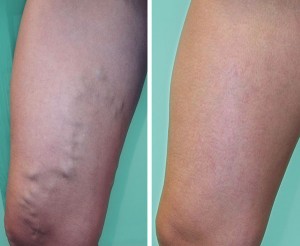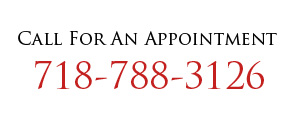Varicose Veins
Varicose veins are enlarged, rope-like veins that occur in the legs of both men and women. Often dark blue in color, they appear near or even raised above the surface of the skin. Any vein may become varicose, but the veins most commonly affected are those in your legs and feet.
Varicose veins don't develop suddenly. In fact, they usually take years to form. While they're often inherited, anyone can get them. And they're common for people who have had certain types of leg injuries or deep-vein blood clots. And in the United States, Varicose veins are a common condition affecting up to 15 percent of men and up to 25 percent of women.
Another factor for developing varicose veins is doing work that requires standing or sitting for long periods of time. This deprives the veins in your legs of the regular bloodflow that occurs when your leg muscles flex during walking and other activities.
As you go about your day, blood flows from your heart to the rest of your body through arteries. It then returns to the heart through veins. It first collects in small superficial veins, then flows into larger veins that have one-way valves to keep the blood from flowing backward.
In healthy veins, these valves make sure the blood is directed upward and inward toward the heart and lungs. But when one or more of these valves do not work properly, some of the blood leaks and flows back down the leg. This causes the vein to overfill with blood, making the branches of those small superficial veins bulge under the skin.
The deep veins can withstand this pressure, partly because of their construction and partly because they're surrounded by muscles. But over time, this extra pressure can cause superficial veins to become distended. And without treatment, chances are they will become varicose veins.
As these superficial veins weaken further, more and more blood accumulates under pressure and causes swelling. Eventually, the valves no longer close at all and blood begins to pool in the superficial veins of the lower leg. These engorged, rope-like veins (varicose veins) are abnormal yet common and mostly affect women.

Who Is At Risk?
While the underlying cause of varicose veins is unknown, a number of risk factors have been identified:
- Heredity – Varicose veins tend to run in families. If your parents, grandparents, aunts, uncles or other family members have had varicose veins, it's likely that you'll develop them. A defect in the vein walls or valves is the greatest contributing factor in 70% of cases.
- Gender – Primarily due to the production of progesterone (one of the major female hormones), females are more likely than men to get varicose veins (by a ratio of 4:1).
- Age – Varicose veins is a progressive condition that worsens in frequency and severity with age. As we age, elastic fibers in our bodily tissues break down, leading to wrinkles in the skin and weakening of the blood vessels.
- Obesity – Excess bodyweight increases the pressure on vein valves and can lead to their weakening.
- Hormones – Changes in hormone levels brought on by puberty, pregnancy, menopause, hormone replacement therapy and contraceptives are risk factors for varicose veins.
- Pregnancy– Increased progesterone levels, blood volume in the body and pressure on the pelvic veins all contribute to the formation of varicose veins.
Symptoms of Varicose Veins
Varicose veins are common and are not generally associated with more severe health problems. But they can be painful, unattractive and worsen over time. Varicose veins can cause legs and feet to swell, a sense of fatigue or restlessness in leg muscles, and throbbing and cramping at night. The skin surrounding the veins may also itch and burn. In severe cases, venous insufficiency may develop, causing irregular circulation. This can lead to problems like deep-vein thrombosis (a blood clot).
Patients with venous insufficiency often benefit from medical treatment. Left untreated, varicose veins can lead to swelling, increased pain, skin discoloration and ulcers. These ulcers are difficult to treat and can easily become infected and painful. When it comes to varicose veins, early diagnosis and treatment are key.
Two or more of the below symptoms at or near the same time may be a sign of varicose veins. A rash or skin ulceration on the ankle or lower leg may also be an indication of varicose veins. Be sure to consult your physician, especially if you see large, rope-like, twisted-looking veins that appear deep-bluish in color. Early symptoms of varicose veins include:
- Aching, heavy legs (often worse at night and after exercise)
- Ankle swelling
- A brownish-blue shiny skin discoloration around the veins
- Skin over the vein may become dry, itchy and thin, leading to eczema (venous eczema)
- The skin may darken (stasis dermatitis), because of the waste products building up in the legs.
How Can Varicose Veins Be Treated
Our physicians use both endovenous radiofrequency treatment (EVRF) and ultrasound-guided sclerotherapy to treat varicose veins.
Endovenous radiofrequency treatment (sometimes referred to as EVRF) is a minimally invasive treatment that requires no hospitalization and no complicated surgery. The entire procedure, from start to finish, takes about an hour and there is very little or no pain. Another advantage to treating varicose veins with EVRF is that most insurance plans and Medicare cover it.
For larger varicose veins, our physicians utilize ultrasound-guided sclerotherapy. The ultrasound provides a live view of your veins, allowing the physician to inject the sclerosant into the precise location for the best treatment results. Once the vein is closed, the blood that was circulating through the abnormal vein is naturally rerouted to other healthy veins. Over time, the treated vein is absorbed by the body. Varicose and spider veins can be uncomfortable and may get worse if left untreated.
News & Events


A Web-based patient portal where you can simply and securely
- Fill out registration forms
- Request appointments
- Request prescription renewals
It's fast, it's easy, and it's convenient








